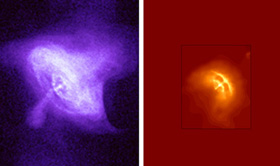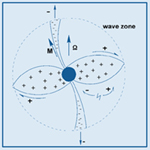|
sol etal
 West Mesa in Chaco Canyon, just outside the great
house called Peņasco Blanco, is a panel containing three symbols: a large star, a crescent moon, and a handprint...June 1054 A.D., a massive star in the constellation Taurus exhausted its supply of nuclear fuel, underwent gravitational
collapse, and then exploded in a supernova. The expanding ejecta of this cosmic explosion gave rise to what is now
the Crab Nebula, as first suggested in 1928 by the astronomer Edwin Hubble. Around 4-5 July 1054 the supernova was visible
in broad daylight, having reached a maximum brightness about ten times that of Venus, the brightest astronomical object visible
from Earth besides the Sun and Moon. It remained visible by day for 23 days, and by night for 653 days. West Mesa in Chaco Canyon, just outside the great
house called Peņasco Blanco, is a panel containing three symbols: a large star, a crescent moon, and a handprint...June 1054 A.D., a massive star in the constellation Taurus exhausted its supply of nuclear fuel, underwent gravitational
collapse, and then exploded in a supernova. The expanding ejecta of this cosmic explosion gave rise to what is now
the Crab Nebula, as first suggested in 1928 by the astronomer Edwin Hubble. Around 4-5 July 1054 the supernova was visible
in broad daylight, having reached a maximum brightness about ten times that of Venus, the brightest astronomical object visible
from Earth besides the Sun and Moon. It remained visible by day for 23 days, and by night for 653 days.

Chandra images of the Crab Nebula 
A generic pulsar model showing polar caps, and equatorial belts of particles. The particles
are driven away by the intense waves that form near the equator some distance away from the neutron star. The magnetic axis
(M) and the spin axis (Omega) are not aligned.
Particles near the equator will be flung outward at near the speed of light by electromagnetic-centrifugal
forces. As this wind of particles streams away from the pulsar, it builds up a magnetized cloud of high-energy particles that
extends over several light years
 |
|
|
Since its launch in 1990, NASA's Hubble Space Telescope has watched a celestial
drama unfold at a stellar demolition site. A shock wave unleashed during a stellar explosion, called Supernova 1987A (SN 1987A),
has been racing toward a ring of matter encircling the blast site. Astronomers used Hubble to monitor the ring for signs of
the impending bombardment. They detected the first evidence of a collision in 1996 [the bright spot at 11 o'clock in the Feb.
6, 1998 image]. Subsequent observations show dozens more "hot spots" as the blast wave slammed into the ring, compressing
and heating the gas, and making it glow. These images, taken by the
Wide Field and Planetary Camera 2 and the Advanced Camera for Surveys, are being released to mark the 17th anniversary of
the supernova's discovery. The most recent observations, taken Jan. 5, Aug. 12, and Nov. 28, 2003 by the Advanced Camera for
Surveys, show many bright spots along a ring of gas, like pearls on a necklace. The temperature of the hot spots surges from
a few thousand degrees to a million degrees Fahrenheit. Curiously, one of the flares on the ring [at 4 o'clock] is just a
star that happens to lie along the telescope's line of sight.
Individual hot spots cannot be seen from ground-based telescopes. Only
Hubble can resolve them. Since most astronomical events occur over thousands or millions of years, this is a unique opportunity
to watch large-scale changes in an object over just a few years. Astronomers also are learning how shock waves really work
in the debris of an exploding star.
SN 1987A was the brightest exploding star seen in 400 years when astronomers
spotted it on Feb. 23, 1987. The violent death of a star 20 times more massive than the Sun, called a supernova, created this
stellar drama. The star actually exploded about 160,000 years ago, but it has taken that long for its light to reach Earth.
The supernova resides in the Large Magellanic Cloud, a nearby small galaxy that is a satellite of our Milky Way galaxy.The ring, about a light-year across, already existed when the star exploded. Astronomers
believe the star shed the ring about 20,000 years before the supernova blast. The ring is glowing in the early Hubble photos
because it is being heated by ultraviolet radiation from the exploding star. As the gas cooled, the ring began to fade, only
to be illuminated again by the shock wave, which is delivering a sledgehammer blow to the ring. This is a rare opportunity
for astronomers to see exactly how a supernova explosion is transformed into a supernova remnant, the glowing, expanding gaseous
remains of a supernova blast. The elongated and expanding object in
the middle of the ring is debris from the supernova blast. The elliptical shape of the supernova debris provides clues to
the violent events that took place deep within the exploding star. The glowing debris is being heated by radioactive elements,
principally titanium 44, that were created in the supernova explosion. The debris will continue to glow for many decades.
In a few years, the entire ring will be ablaze as it absorbs the full
force of the crash. The glowing ring is expected to become bright enough to illuminate the star's surroundings, thus providing
astronomers with new information on how the star ejected material before the explosion.
 |
Credit: NASA,
|
|
0 
[UPPER LEFT] - A close-up high
resolution Wide Field Planetary Camera 2 image of the dramatic dust disk which is thought to be the remnant of a smaller spiral
galaxy that merged with the large elliptical galaxy. The shock of the collision compressed interstellar gas, precipitating
a flurry of star formation and giving the material a fleecy pattern. Dark filaments of dust mixed with cold hydrogen gas are
silhouetted against the incandescent yellow-orange glow from stars behind it.
Probing a Quasar's Home
 |
|
|
Images taken by the Hubble Space Telescope have allowed astronomers to clearly see the link between quasars and their companion
galaxies. Some quasars, such as the one in this two-panel image, have been caught in the act of merging or colliding with
their companion galaxies.The image on the left reveals the huge, thin tidal arms of a galaxy associated with the luminous
quasar, which is 1.5 billion light-years from Earth. The odd-shaped arms suggest an encounter between the quasar and a companion
galaxy. The thick bright line above the quasar is an edge-on background galaxy. In the right-hand panel, the same image is
shown at a different contrast level, which enables astronomers to peer closer into the galaxy's nucleus. Only 11,000 light-years
separate the quasar and the companion galaxy (located just above the quasar). This galaxy is similar in size and brightness
to the Large Magellenic Cloud galaxy near our Milky Way. The galaxy is closer to the quasar's center than our sun is to the
center of our galaxy. The quasar and galaxy are drawn together by strong gravitational forces. Eventually, the galaxy will
fall into the quasar's engine, the black hole. Black holes are believed to power the compact, energetic quasars. The black
hole will gobble up this companion galaxy in no more than 10 million years.
as I have written before and I would be thrilled if you post it is in the holgraphic principle there remains a higher
dimension that explains why we can calculate facts about black holes. My theory suggests that this greater dimension may be
interferring causing short grbs, also I have suggested possible brane interference grb.sonoma.edu GRBs appear to be divided into two classes: those shorter than 2 seconds, and those longer than 2 seconds. If this classification
scheme is correct, then it would follow that there are two different causes for the bursts. However, there are other properties
of the bursts which differ and could lead to alternative explanations. The jury is still out as to the classification scheme
and the associated mechanisms, especially for the shorter class of bursts SGR 1806-20 Blast I noticed that seconds after the initial blast of light, a doppler-like wave emanated from
that point and seemed to fly past the SWIFT camera. This "wave" appeared to be traveling at close to light speed, what was
it's composition? Referring Page: http://swift.sonoma.edu/resources/multimedia/images/
Answer provided by Lynn Cominsky (SSU E/PO Director):
The wave in question represented the light coming from the SGR
in the initial blast. The animation showed it as coming out afterwards, this was incorrect.
A common event often mistaken by people in the sky to be a Gamma-Ray burst is an Iridium Flare. If you visit this link
http://www.heavens-above.com, then put in your latitude and longitude, you will be able to see if there were any of these flares reported during this
time.
Fomalhaut, a 200-million-year-old
star, is a mere infant compared to our own 4.5-billion-year-old Sun. It resides 25 light-years away from the Sun. Located
in the constellation Piscis Austrinus (the Southern Fish), the Fomalhaut ring is ten times as old as debris disks seen previously
around the stars AU Microscopii and Beta Pictoris, where planets may still be forming. If our solar system is any example,
planets should have formed around Fomalhaut within tens of millions of years after the birth of the star. The Hubble images also provide a glimpse of the outer planetary region
surrounding a star other than our Sun. Many of the more than 100 planets detected beyond our solar system are orbiting close
to their stars. Most of the current planet-detecting techniques favor finding planets that are close to their stars. "The size of Fomalhaut's dust ring suggests that not all planetary
systems form and evolve in the same way — planetary architectures can be quite different from star to star," Kalas explained.
"While Fomalhaut's ring is analogous to the Kuiper Belt, its diameter is four times greater than that of the Kuiper Belt."The astronomers used the Advanced Camera for Surveys' (ACS) coronagraph
aboard Hubble to block out the light from the bright star so they could see details in the faint ring.
A huge, billowing pair of gas and dust clouds is the super-massive
star Eta Carinae.
Even though Eta Carinae is more than 8,000 light-years away,
features 10 billion miles across (about the diameter of our solar system) can be distinguished. Eta Carinae suffered giant
outburst about 150 years ago, when it became one of the brightest stars in the southern sky. Though the star released as much
visible light as a supernova explosion, it survived the outburst. Somehow, the explosion produced two lobes and a large, thin
equatorial disk, all moving outward at about 1.5 million miles per hour. Estimated to be 100 times heftier than our Sun, Eta
Carinae may be one of the most massive stars in our galaxy.


A Martian Dust Devil Passes
we are so fortunate that the general science community is so benevolent with their freedom to access all sorts of
wonderful information. This awesome NASA pic is no exception. Moving pictures from the surface of Mars...?

Our Business Philosophy
Our mission statement..... A Hitchhiker's Guide to the Moon  Imagine trekking in a lunar rover across miles of the Moon's rough surface. Your mission: to explore a crater with suspected
deposits of ice. Image left: When traveling on the Moon, don't forget your map!
Ion Thrusters Propel NASA into Future
|
05.27.05
|
We are a curious species with amazing capacities to imagine and dream. We wonder
about what we cannot see, are fascinated by what we do not know and are driven to explore.
In keeping with our continuous
quest for knowledge, President George W. Bush announced a new plan for NASA in Jan. 2004. A renewed focus on space exploration,
he explained, would strengthen our leadership in the world, improve our economy and enhance the quality of our lives.
 The Vision for Space Exploration calls for human and robotic missions to the Moon, Mars and beyond. To realize these ambitious
goals, we will need more powerful and efficient propulsion and power-generation systems -- systems that can thrust a spacecraft
out of Earth's orbit to the far reaches of the Universe. The Vision for Space Exploration calls for human and robotic missions to the Moon, Mars and beyond. To realize these ambitious
goals, we will need more powerful and efficient propulsion and power-generation systems -- systems that can thrust a spacecraft
out of Earth's orbit to the far reaches of the Universe. |
|
|


 West Mesa in Chaco Canyon, just outside the great
house called Peņasco Blanco, is a panel containing three symbols: a large star, a crescent moon, and a handprint...June 1054 A.D., a massive star in the constellation Taurus exhausted its supply of nuclear fuel, underwent gravitational
collapse, and then exploded in a supernova. The expanding ejecta of this cosmic explosion gave rise to what is now
the Crab Nebula, as first suggested in 1928 by the astronomer Edwin Hubble. Around 4-5 July 1054 the supernova was visible
in broad daylight, having reached a maximum brightness about ten times that of Venus, the brightest astronomical object visible
from Earth besides the Sun and Moon. It remained visible by day for 23 days, and by night for 653 days.
West Mesa in Chaco Canyon, just outside the great
house called Peņasco Blanco, is a panel containing three symbols: a large star, a crescent moon, and a handprint...June 1054 A.D., a massive star in the constellation Taurus exhausted its supply of nuclear fuel, underwent gravitational
collapse, and then exploded in a supernova. The expanding ejecta of this cosmic explosion gave rise to what is now
the Crab Nebula, as first suggested in 1928 by the astronomer Edwin Hubble. Around 4-5 July 1054 the supernova was visible
in broad daylight, having reached a maximum brightness about ten times that of Venus, the brightest astronomical object visible
from Earth besides the Sun and Moon. It remained visible by day for 23 days, and by night for 653 days.













 Imagine trekking in a lunar rover across miles of the Moon's rough surface. Your mission: to explore a crater with suspected
deposits of ice.
Imagine trekking in a lunar rover across miles of the Moon's rough surface. Your mission: to explore a crater with suspected
deposits of ice.  The Vision for Space Exploration calls for human and robotic missions to the Moon, Mars and beyond. To realize these ambitious
goals, we will need more powerful and efficient propulsion and power-generation systems -- systems that can thrust a spacecraft
out of Earth's orbit to the far reaches of the Universe.
The Vision for Space Exploration calls for human and robotic missions to the Moon, Mars and beyond. To realize these ambitious
goals, we will need more powerful and efficient propulsion and power-generation systems -- systems that can thrust a spacecraft
out of Earth's orbit to the far reaches of the Universe.